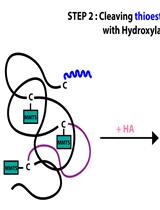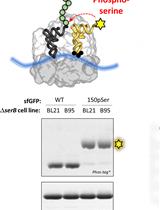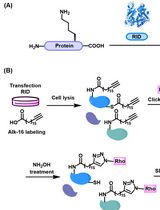- EN - English
- CN - 中文
In vitro Enzymatic Assays of Histone Decrotonylation on Recombinant Histones
以重组组蛋白为底物的去巴豆酰化作用的体外酶学分析
发布: 2018年07月20日第8卷第14期 DOI: 10.21769/BioProtoc.2924 浏览次数: 6955
评审: David CisnerosDamián Lobato-MárquezAnonymous reviewer(s)

相关实验方案

一种改良的酰基-RAC方法分离视网膜棕榈酰蛋白质组,并通过LC-MS/MS进行后续检测
Sree I. Motipally [...] Saravanan Kolandaivelu
2023年04月20日 1992 阅读
Abstract
Class I histone deacetylases (HDACs) are efficient histone decrotonylases, broadening the enzymatic spectrum of these important (epi-)genome regulators and drug targets. Here, we describe an in vitro approach to assaying class I HDACs with different acyl-histone substrates, including crotonylated histones and expand this to examine the effect of inhibitors and estimate kinetic constants.
Keywords: Crotonylation (酰化)Background
Posttranslational modifications of histones are an important facet of genome regulation, including gene expression (for example see Pengelly et al., 2013; reviewed in Castillo et al., 2017). Histone modifications alter chromatin structure and/or regulate the binding of proteins, such as nucleosome remodeling factors (reviewed in Bannister and Kouzarides, 2011). Most histone modifications are reversible and can be removed enzymatically. For example, histone acetylation is removed by histone deacetylases (HDACs), of which there exist several classes. In recent years new histone lysine acylations, including succinylation, propionylation, butyrylation, hydroxybutyrylation and crotonylation have emerged as new alternative acylations to the canonical histone acetylation and the functional relevance of many of these newly discovered histone modifications have been demonstrated (reviewed in Sabari et al., 2017). In particular, histone crotonylation is associated with active gene expression and is thought to be influenced by the metabolic state of the cell (Sabari et al., 2015; Fellows et al., 2018). Class I histone deacetylases have recently been shown to also efficiently decrotonylate histones (Wei et al., 2017; Fellows et al., 2018).
Histone deacetylation assays are often performed using fluorescent acetyl substrates, such as BOC-lys(acetyl)-AMC, because this allows high-throughput in vitro approaches, suitable for drug discovery (Wegener et al., 2003a; 2003b and 2003c). However, we found that the analogous fluorescent crotonyl substrate BOC-lys(crotonyl)-AMC was inhibitory to histone deacetylases (Fellows et al., 2018). In this protocol, we describe a method for analysis of the activity of histone deacetylases with in vitro crotonylated histone H3, and we investigate the effect of an inhibitor and estimate kinetic parameters using an in vitro approach. This method does not require the use of radioisotopes. It also does not rely on fluorescent peptide mimics, and thus, the kinetic constants determined may be more representative of those found in vivo. The approach depends on the recognition of histone acylations, such as crotonylation, by specific antibodies. It is a versatile approach, which could be applied to study a variety of other histone modifications, enzymes, and inhibitors.
Materials and Reagents
- 8-strip 0.2 ml non-flex flat cap PCR tubes with individual lids (STARLAB INTERNATIONAL, catalog number: I1402-3700 )
- 250 ml and 1 L cylinders (Corning, catalog number: 3022P-250 , 3022P-1L )
- Pre-cut extra thick blot paper, 7 x 8.4 cm (Bio-Rad Laboratories, catalog number: 1703966 )
- Amersham Protran 0.45 µm nitrocellulose membrane, 300 mm x 4 m (GE Healthcare, catalog number: 10600002 )
- 5, 10 and 25 ml Costar® Stripette® serological pipettes (Corning, catalog numbers: 4487 , 4488 , 4489 )
- 50 ml Falcon® tubes, polypropylene (Corning, catalog number: 352070 )
- Eppendorf® tubes 5.0 ml, Eppendorf QualityTM (Eppendorf, catalog number: 0030119401 )
- X-ray film 18 x 24 cm double sided (Scientific Laboratory Supplies, catalog number: MOL7016 )
- Transparent acetate sheet, e.g., colour copier transparency film (Interaction-Connect, Q-CONNECT®, catalog number: KF00533 )
- Milli-Q® water
- Recombinant human histone H3.1 protein, 1 mg/ml (New England Biolabs, catalog number: M2503S )
Note: Prepare aliquots (e.g., 10 µl aliquots) and store at -80 °C. - Recombinant catalytic domain of human p300 protein (Enzo Life Sciences, catalog number: BML-SE451-0100 ), 100 µg, 15.18 µM (exact concentration may vary by batch, check the tube)
Note: Prepare aliquots (e.g., 10 µl aliquots) and store at -80 °C. - Crotonyl-coenzyme A trilithium salt ~90% pure as per HPLC (Sigma-Aldrich, catalog number: 28007 )
Note: For acetylation we used: Acetyl-coenzyme A (Sigma-Aldrich, catalog number: ACOA-RO ROCHE). Prepare 5 mM stock solution in water, aliquot and store at -80 °C.
Manufacturer: Roche Diagnostics, catalog number: 10101893001 . - Trizma®-hydrochloride, ≥ 99.0% (Sigma-Aldrich, catalog number: T3253 )
- Potassium chloride, 99.5-101.0% AnalaR NORMAPUR® (VWR, catalog number: 26764.298 )
- UltraPureTM 0.5 M EDTA, pH 8.0 (Thermo Fisher Scientific, catalog number: 15575020 )
- Tween 20 (Sigma-Aldrich, catalog number: P1379 )
- Glycerol, ≥ 99% (Sigma-Aldrich, catalog number: G5516 )
- Dithiothreitol (DTT) (Thermo Fisher Scientific, catalog number: R0861 )
- Magnesium chloride hexahydrate, ≥ 99.0% (Sigma-Aldrich, catalog number: M2670 )
- Zinc sulfate heptahydrate (Sigma-Aldrich, catalog number: Z0251 )
- Recombinant human HDAC1 protein (Active Motif, catalog number: 31908 ) 50 µg, 0.1 mg/ml, 1.78 µM (exact concentration may vary by batch, check tube)
Note: Prepare aliquots (e.g., 10 µl aliquots) and store at -80 °C. - 2x Laemmli sample buffer (Bio-Rad Laboratories, catalog number: 1610737 )
Note: Add 2-mercaptoethanol to 5% v/v as described by supplier. - 2-mercaptoethanol, ≥ 99.0% (Sigma-Aldrich, catalog number: M6250 )
- Sodium Butyrate, 98% (Sigma-Aldrich, catalog number: 303410 )
Note: Prepare a 1 M solution in water, adjust to pH 7 and aliquot. - Precast RunBlue 4-12% Bis-Tris (Expedeon, catalog number: NBT41227 )
- 20x RunBlue MES run buffer (Expedeon, catalog number: NXB70500 )
- PageRulerTM Prestained protein ladder, 10 to 180 kDa (Thermo Fisher Scientific, catalog number: 26616 )
- 10x Tris/glycine/SDS electrophoresis buffer (Bio-Rad Laboratories, catalog number: 1610732EDU )
- UltraPureTM Tris buffer (Thermo Fisher Scientific, catalog number: 15504020 )
- Glycine, ≥ 99.7% AnalaR NORMAPUR® (VWR, catalog number: 101196X )
- Methanol, ≥ 99.8% AnalaR NORMAPUR® (VWR, catalog number: 20847.307 )
- Sodium chloride, 99.5-100.5% AnalaR NORMAPUR® (VWR, catalog number: 27810.295 )
- Bovine serum albumin, heat shock fraction pH 7 ≥ 98% (Sigma-Aldrich, catalog number: A9647 )
- Anti-crotonyl-histone H3 lys18 (H3K18cr) rabbit polyclonal antibody (PTM Biolabs, catalog number: PTM-517)
- Anti-rabbit IgG HRP linked whole antibody (GE Healthcare, catalog number: NA934-1ML )
- Enhanced chemiluminescence (ECL) Western blotting reagents (GE Healthcare, catalog number: RPN2106 )
- Synthetic crotonylated H3K18cr peptide 95% pure, lyophilized (TGGKAPR-Lys(Crotonyl)-QLATKAA-EDA-Biotin, BioGenes, Peptide 60556.1) (EDA is a spacer amino acid sequence)
- Histone acylation buffer (see Recipe 1)
- HDAC assay buffer (see Recipe 2)
- MES Run buffer (see Recipe 3)
- Tris glycine SDS (TGS) buffer (see Recipe 4)
- Transfer buffer (see Recipe 5)
- Tris-buffered saline, pH 7.5 (TBS) (see Recipe 6)
- TBS with tween 20 (TBS-T) (see Recipe 7)
- TBS-T with 3% (w/v) bovine serum albumin (TBS-T BSA) (see Recipe 8)
Equipment
- Pipettes (Gilson, catalog numbers: F123602 , F123601 , F123600 , F144801 , model: P1000, P200, P20, P2)
- Pipette controller PIPETBOY acu2 (VWR, INTEGRA Biosciences, catalog number: 612-2964 )
- Fume hood (e.g., Protector Xstream Laboratory Hood, Labconco)
- Milli-Q Water Purification System (Merck, catalog number: ZRXQ003WW )
- GE Healthcare AmershamTM HypercasetteTM Autoradiography Cassette (GE Healthcare, catalog number: RPN11643 )
- Vortex-genie 2 (Scientific Industries, model: Vortex-Genie 2 , catalog number: SI-0236)
- Microcentrifuge (STARLAB INTERNATIONAL, model: Mini Fuge, catalog number: N2631-0007 )
- Two T100TM Thermal Cyclers (Bio-Rad Laboratories, catalog number: 1861096 )
- Amersham electrophoresis power supply EPS 301 (GE Healthcare, catalog number: 18113001 )
- XCell SureLockTM Mini-Cell Electrophoresis System (Thermo Fisher Scientific, catalog number: EI0001 )
- Transblot® SD semi-dry electrophoretic transfer cell (Bio-Rad Laboratories, catalog number: 1703940 )
- MI-5 x-ray film processor (Jet X-Ray, model: Mi5 )
- Epson expression 1680 scanner (Seiko Epson, model: Epson Expression 1680 )
Note: Equivalent models of equipment specified here may also be used.
Software
- ImageJ version 1.50 b
- Windows Excel 2016
- Adobe Illustrator CC 2015.3
- Graphpad Prism version 7.0
- Epson Scan Software in professional mode
Note: Other versions of this software or similar software may be used but the instructions specified in the data analysis section may then differ.
Procedure
文章信息
版权信息
© 2018 The Authors; exclusive licensee Bio-protocol LLC.
如何引用
Fellows, R. and Varga-Weisz, P. (2018). In vitro Enzymatic Assays of Histone Decrotonylation on Recombinant Histones. Bio-protocol 8(14): e2924. DOI: 10.21769/BioProtoc.2924.
分类
生物化学 > 蛋白质 > 翻译后修饰
分子生物学 > 蛋白质 > 脱酰作用
您对这篇实验方法有问题吗?
在此处发布您的问题,我们将邀请本文作者来回答。同时,我们会将您的问题发布到Bio-protocol Exchange,以便寻求社区成员的帮助。
提问指南
+ 问题描述
写下详细的问题描述,包括所有有助于他人回答您问题的信息(例如实验过程、条件和相关图像等)。
Share
Bluesky
X
Copy link












